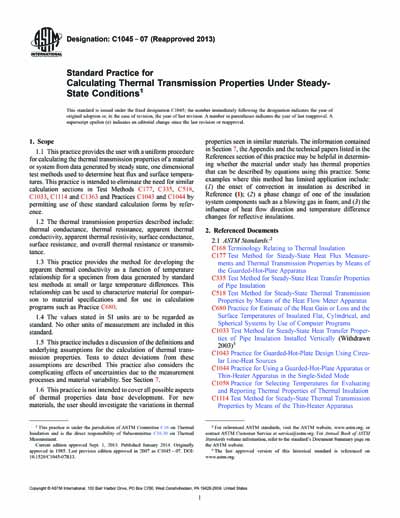Historical
ASTM C1045-07(2013)
Standard Practice for Calculating Thermal Transmission Properties Under Steady-State Conditions
1.1 This practice provides the user with a uniform procedure for calculating the thermal transmission properties of a material or system from data generated by steady state, one dimensional test methods used to determine heat flux and surface temperatures. This practice is intended to eliminate the need for similar calculation sections in Test Methods C177, C335, C518, C1033, C1114 and C1363 and Practices C1043 and C1044 by permitting use of these standard calculation forms by reference.
1.2 The thermal transmission properties described include: thermal conductance, thermal resistance, apparent thermal conductivity, apparent thermal resistivity, surface conductance, surface resistance, and overall thermal resistance or transmittance.
1.3 This practice provides the method for developing the apparent thermal conductivity as a function of temperature relationship for a specimen from data generated by standard test methods at small or large temperature differences. This relationship can be used to characterize material for comparison to material specifications and for use in calculation programs such as Practice C680.
1.4 The values stated in SI units are to be regarded as standard. No other units of measurement are included in this standard.
1.5 This practice includes a discussion of the definitions and underlying assumptions for the calculation of thermal transmission properties. Tests to detect deviations from these assumptions are described. This practice also considers the complicating effects of uncertainties due to the measurement processes and material variability. See Section 7.
1.6 This practice is not intended to cover all possible aspects of thermal properties data base development. For new materials, the user should investigate the variations in thermal properties seen in similar materials. The information contained in Section 7, the Appendix and the technical papers listed in the References section of this practice may be helpful in determining whether the material under study has thermal properties that can be described by equations using this practice. Some examples where this method has limited application include: ( 1) the onset of convection in insulation as described in Reference (1); (2) a phase change of one of the insulation system components such as a blowing gas in foam; and (3) the influence of heat flow direction and temperature difference changes for reflective insulations.
ASTM International [astm]

